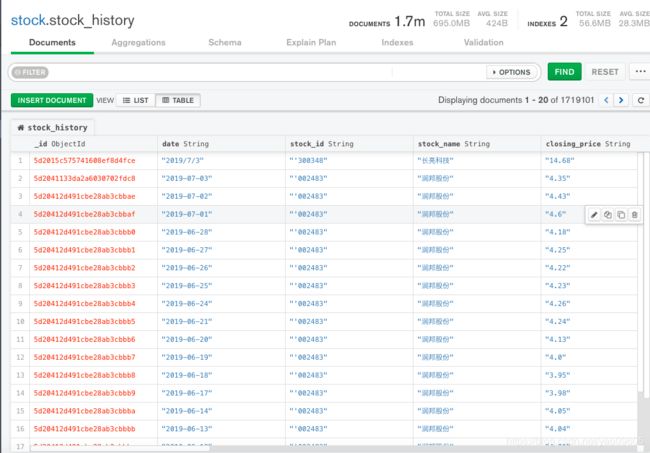【python】遍历一个目录下的所有CSV并插入MONGODB
上一篇讲到把股票的历史数据下载成了CSV,查看虽然方便,但还是希望在数据库中存一份,方便存储和操作。
对新建的表还是和之前一样在mongodb compass里面插入一条记录,并建立索引

话不多说直接上代码:
'''
this file is used to import all scv under a directory into mongodb
'''
# encoding:latin1
import os
import pymongo
import csv
from pymongo import MongoClient
from pymongo import errors
import codecs
def str_to_hex(s):
return ' '.join([hex(ord(c)).replace('0x', '') for c in s])
def analysis_file(file):
csv_file = csv.reader(file) # 将读入的文件转换成csv.reader对象
head_row = next(csv_file) #去除第一行标题
for row in csv_file:
history_item = dict()
history_item["date"] = row[0]
history_item["stock_id"] = row[1]
history_item["stock_name"] = row[2]
history_item["closing_price"] = row[3]
history_item["highest_price"] = row[4]
history_item["lowest_price"] = row[5]
history_item["open_price"] = row[6]
history_item["last_closing_price"] = row[7]
history_item["rise_amount"] = row[8]
history_item["rise_range"] = row[9]
history_item["turn_over_rate"] = row[10]
history_item["turn_over_hand"] = row[11]
history_item["turn_over_amount"] = row[12]
history_item["market_value"] = row[13]
history_item["circulation_market_value"] = row[14]
# print(history_item)
try:
collection.insert(history_item)
except errors.DuplicateKeyError:
pass
def read_file_list(file_path):
file_list = os.listdir(file_path) #读取路径下所有文件名
for file in file_list:
if file[-3:] != 'csv': # 检查是不是csv文件
continue
path = os.path.join(file_path, file) # 通过文件夹路径和文件名生成文件绝对路径
print(path)
f = codecs.open(path, 'rb', 'gbk') # 使用适合的编码打开文件,不知道的话就多试几下
analysis_file(f)
if __name__ == '__main__':
client = MongoClient('127.0.0.1:27017') #连接mongodb
db = client['stock'] #选择库
collection = db['stock_history'] # 选择表
read_file_list('/stock_history/stock_history/history_data') # 路径自定义
